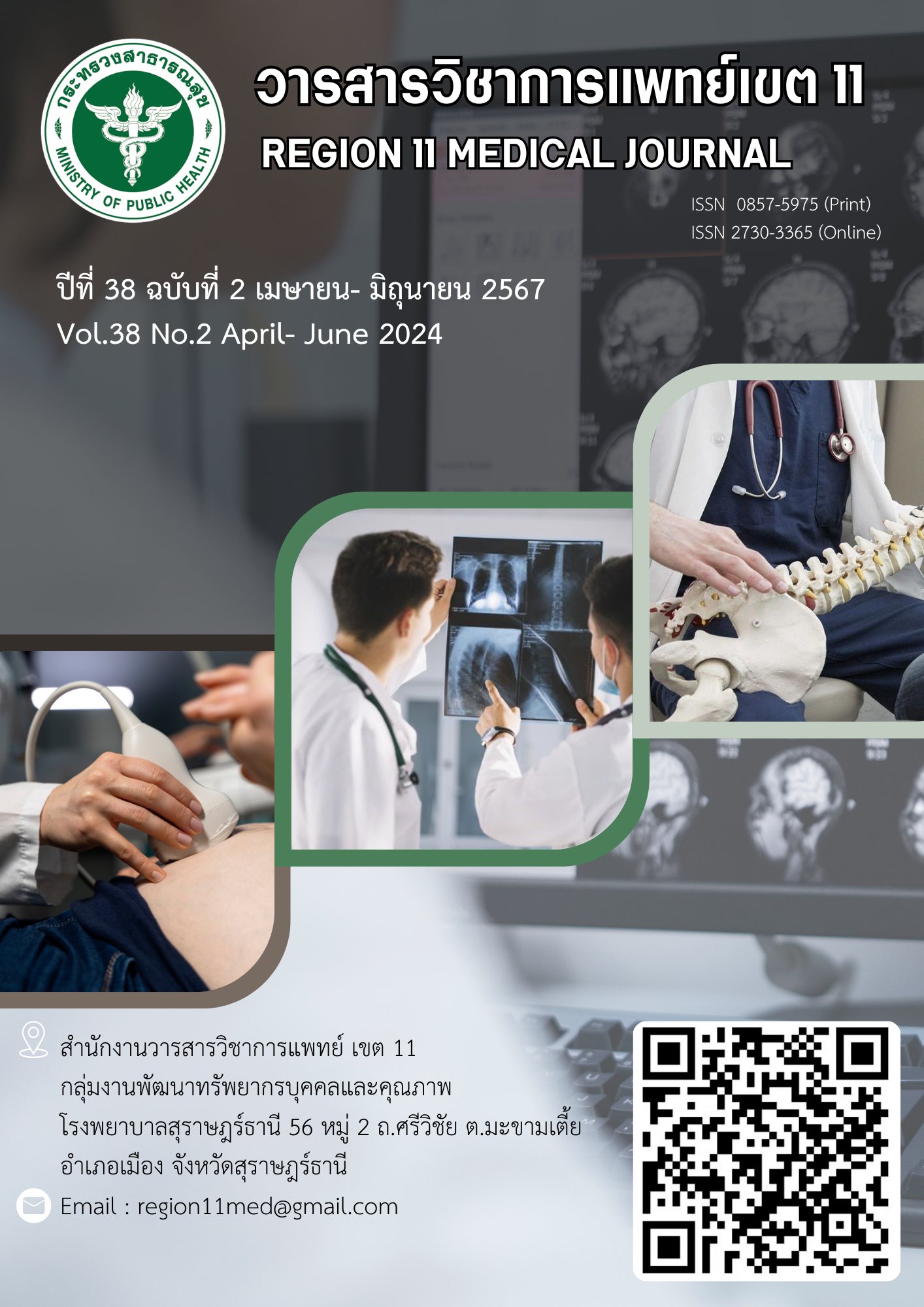Comparative effect of telemedicine on glycemic control management among Diabetes Mellitus Type II Patients in Suratthani’s prison healthcare unit.
Keywords:
Telemedicine, In-person Care, Diabetes Mellitus Type II PatientsAbstract
Background: Telemedicine offers many benefits to conventional care such as decreased travel cost and time, decreased risk of transmission of communicable diseases. However after the end of COVID-19 outbreak the researcher concerns the comparative effect of telemedicine on glycemic control between telemedicine and in-person care.
Objectives: to evaluate the effect of telemedicine on behaviors and blood sugar control among diabetes patients in Suratthani’s prison healthcare unit.
Methods: A Quasi-experimental study into 2 groups Telemedicine and In-person care, using a questionnaire in Type II diabetes patients during December 1st, 2023 to April 1st, 2024. Descriptive statistics were used with Independent t test and Paired t-test.
Results: There were 45 participants enrolled the study. The behaviors scores between two groups are moderate =3.09, S.D.= 0.33 and =2.94, S.D.= 0.33, respectively slightly different non- significant (P=0.14). The comparative impact on glycemic control (FBS and Hba1c) in the telemedicine group decrease less than In-person care (Tele: Pre FBS =119.8 ,Post FBS =114.4), (In-person:Pre FBS =128.9 ,Post FBS =125.2), (Tele:Pre Hba1c =7.1, In-person:Post Hba1c =6.9) and (In-perdson:Pre Hba1c =7.9 ,Post Hba1c =6.9), respectively non significant. Paired different Hba1c reduction in telemedicine group was 0.21% non significant (P=0.46) and In-person group was 1.11% significantly (P<0.05).
Conclusions: Telemedicine benefits diabetes patients in prison to decrease blood sugar control. It increases patients’ accessibility and save cost of the treatment. Therefore telemedicine could improve the workflow of hospitals and prison health care unit in the future.
References
สำนักโรคไม่ติดต่อ กรมควบคุมโรค กระทรวงสาธารณสุข. จำนวนและอัตราผู้ป่วยในปี 2563 – 2565 [อินเตอร์เน็ต]. [เข้าถึงเมื่อ 10 ตุลาคม 2566] เข้าถึงได้จาก http://thaincd.com/2023/mission.%20document-detail.php.
ระบบรายงานข้อมูล HDC 2566.ข้อมูลสถานะสุขภาพ[อินเตอร์เน็ต]. [เข้าถึงเมื่อ 10 ตุลาคม 2566] เข้าถึงได้จาก https://sni.hdc.moph.go.th/hdc/reports/report.php?&cat_id=6a1fdf282fd28180eed7d1cfe0155e11&id=589248f2516fbb85d4a4a5605c3ca1c4
แพทยสภา. ประกาศแพทยสภา เรื่องแนวทางปฏิบัติการแพทย์ทางไกลหรือโทรเวช (telemedicine) และคลินิกออนไลน์ [อินเตอร์เน็ต]. [เข้าถึงเมื่อ 22 ตุลาคม 2566] เข้าถึงได้จาก https://tmc.or.th/index.php/News/News-and-Activities/Telemedicine
กองบริหารการสาธารณสุข สำนักปลัดกระทรวงสาธารณสุข. การดำเนินการจัดบริการทางการแพทย์วิถีใหม่ (New Normal Medical Service) สมุทรปราการ: บริษัทบอร์นทูบีพับลิซซิ่งจำกัด; 2563.
Becker, M.H. (1974) The Health Belief Model and Personal Health Behavior. Health Education Monographs, 2, 324- 508.
Bloom, Benjamin S. Learning for mastery. Evaluation comment. Center for the study of instruction program. University of California 1968; 2 :47-62.
เพ็ญศรี พงษ์ประภาพันธ์, สุวิมล แสนเวียงจันทร์ และประทีป ปัญญา. (2553). การพัฒนารูปแบบการส่งเสริมสุขภาพแบบองค์รวมของผู้ป่วยเบาหวานในชุมชนวัดปุรณาวาส.
จิรวัฒน์ บุญรักษ์. การพัฒนาระบบการดูแลผู้ป่วยเบาหวานในพื้นที่เกาะ [อินเตอร์เน็ต]. [เข้าถึงเมื่อ 15 ตุลาคม 2566] เข้าถึงได้จาก https://he01.tci-thaijo.org/index.php/shj/article/view/261554
บุษยมาส บุศยารัศมี. ศึกษาเรื่องการพัฒนารูปแบบการดูแลผู้ป่วยเบาหวานหรือความดันโลหิตสูงในยุควิถีใหม่ เขตอำเภอเมือง จังหวัดนครปฐม [อินเตอร์เน็ต]. [เข้าถึงเมื่อ 15 ตุลาคม 2566] เข้าถึงได้จาก https://he02.tci-thaijo.org/index.php/reg45/article/view/262135
กรรณิการ์ ยิ่งยืน. นวัตกรรมเพื่อการจัดการตนเองผ่านระบบบริการสุขภาพทางไกลสำหรับผู้ป่วย เบาหวานชนิดที่ 2 ที่มีภาวะไขมันในเลือดสูง. ศรีนครินทร์เวชสาร 2559. 2559;31.
Kassar K, Roe C, Desimone M. Use of Telemedicine for Management of Diabetes in Correctional Facilities. Telemed J E Health 2017; (1):55-59. doi: 10.1089/tmj.2016.0036.
Faruque LI, Wiebe N, Ehteshami-Afshar A, et al. Effect of telemedicine on glycated hemoglobin in diabetes: a systematic review and meta-analysis of randomized trials. CMAJ 2017;189(9):E341-E364. doi: 10.1503/cmaj.150885.
Downloads
Published
How to Cite
Issue
Section
License
Copyright (c) 2024 Region11Medical Journal

This work is licensed under a Creative Commons Attribution-NonCommercial-NoDerivatives 4.0 International License.






